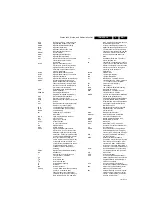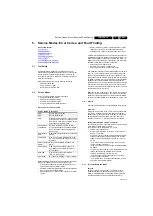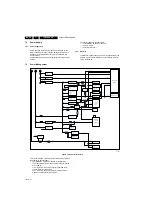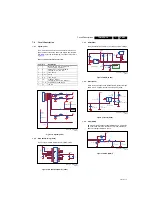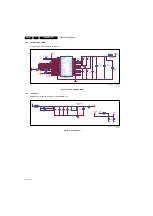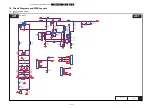
Alignments
6.
6.
Alignments
Index of this chapter:
6.1
General Alignment Conditions
Perform all electrical adjustments under the following
conditions:
•
Power supply voltage: 195 - 264 V
AC
, 50/ 60 ± 3 Hz.
•
Connect the set to the mains via an isolation transformer
with low internal resistance.
•
Allow the set to warm up for approximately 15 minutes.
•
Measure voltages and waveforms in relation to correct
ground (e.g. measure audio signals in relation to
AUDIO_GND).
Caution: It is not allowed to use heat sinks as ground.
•
Test probe: R
i
> 10 M
Ω
, C
i
< 20 pF.
•
Use an isolated trimmer/screwdriver to perform
alignments.
6.2
Hardware Alignments
Not applicable.
6.3
Software Alignments
Put the set in SAM mode (see Chapter
). The SAM menu will now appear on
the screen. Select RGB Align and go to one of the sub menus.
The alignments are explained below.
The following items can be aligned:
•
White point
To store the data:
•
Press OK on the RC before the cursor is moved to the
left
•
Select “Store” and press OK on the RC
•
Switch the set to stand-by mode.
For the next alignments, supply the following test signals via a
video generator to the RF input:
•
EU/AP-PAL models: a PAL B/G TV-signal with a signal
strength of at least 1 mV and a frequency of 475.25 MHz
•
US/AP-NTSC models: an NTSC M/N TV-signal with a
signal strength of at least 1 mV and a frequency of
61.25 MHz (channel 3).
•
LATAM models: an NTSC M TV-signal with a signal
strength of at least 1 mV and a frequency of 61.25 MHz
(channel 3).
6.3.1
Display adjustment
You can use the default values. The default values are average
values coming from production.
•
Enter SAM mode.
•
Select a colour temperature (e.g. COOL, NORMAL, or
WARM).
•
Set the RED, GREEN and BLUE default values according
to the values in
.
•
When finished press OK on the RC, then press STORE to
store the aligned values to the NVM.
•
Restore the initial picture settings after the alignments.
This group setting of colour temperature will be applied
automatically to the TV / VGA / HDMI / AV sources.
Table 6-1 White tone default settings
6.4
Option Settings
6.4.1
Introduction
The microprocessor communicates with a large number of I
2
C
ICs in the set. To ensure good communication and to make
digital diagnosis possible, the microprocessor has to know
which ICs to address. The presence / absence of these
MT5301B ICs (back-end advanced video picture improvement
IC which offers motion estimation and compensation features
(commercially called HDNM) is made known by the option
codes.
6.4.2
Option Code Overview
Enter SAM mode to check the option codes. They can not be
edited in the NVM.
6.4.3
Display Code Overview
Press the following key sequence on a standard RC
transmitter: “062598” directly followed by MENU and “xxx”,
where “xxx” is a 3 digit decimal value of the panel type: see
column “Display Code” in
. When the value is
accepted and stored in NVM, the set will switch to Stand-by, to
indicate that the process has been completed.
Table 6-2 Display code overview
6.5
Reset of Repaired SSB
A very important issue towards a repaired SSB from a Service
repair shop (SSB repair on component level) implies the reset
of the NVM on the SSB.
A repaired SSB in Service should get the service Set type
“00PF0000000000” and Production code “00000000000000”.
Also the virgin bit (MENU > Setup > TV settings > Reinstall TV
> Start now) is to be set. To set all this, you can use the
ComPair tool or use the “NVM editor” and “Service Data” items
in SAM (do not forget to “store”).
After a repaired SSB has been mounted in the set (set repair
on board level), the type number (CTN) and production code of
the TV has to be set according to the type plate of the set. For
this, you can use the NVM editor in SAM. The loading of the
CTN and production code can also be done via ComPair
(Model number programming).
In case of a display replacement, reset the “Operation hours
display” to “0”, or to the operation hours of the replacement
display.
Picture mode
Screen
size
Colour temperature
Red
Green
Blue
Normal
(9000K)
32"
128
113
108
42"
128
125
103
Cool (11000K) 32"
135
128
131
42"
125
128
117
Warm (6500K) 32"
128
100
75
42"
128
111
66
CTN_ALT BOM#
Panel Type
Display Code
32PFL5606S/98
AUO T315HW07
148
42PFL5606S/98
TPV TPT420H2-LE5
142

